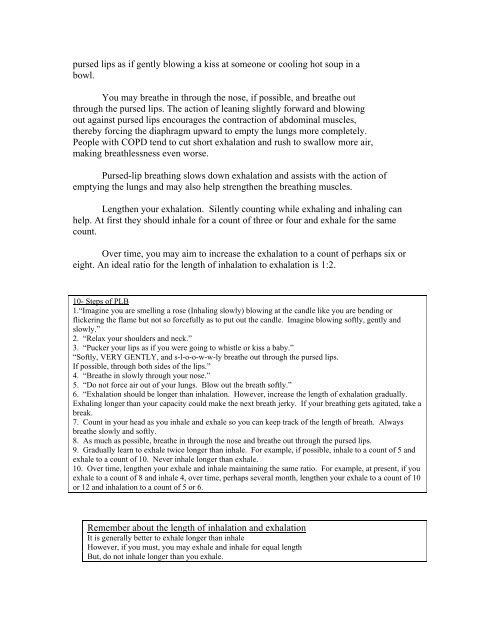Anxiety and Panic Attacks In Emphysema ... - Mind Publications
Anxiety and Panic Attacks In Emphysema ... - Mind Publications
Anxiety and Panic Attacks In Emphysema ... - Mind Publications
Create successful ePaper yourself
Turn your PDF publications into a flip-book with our unique Google optimized e-Paper software.
pursed lips as if gently blowing a kiss at someone or cooling hot soup in a<br />
bowl.<br />
You may breathe in through the nose, if possible, <strong>and</strong> breathe out<br />
through the pursed lips. The action of leaning slightly forward <strong>and</strong> blowing<br />
out against pursed lips encourages the contraction of abdominal muscles,<br />
thereby forcing the diaphragm upward to empty the lungs more completely.<br />
People with COPD tend to cut short exhalation <strong>and</strong> rush to swallow more air,<br />
making breathlessness even worse.<br />
Pursed-lip breathing slows down exhalation <strong>and</strong> assists with the action of<br />
emptying the lungs <strong>and</strong> may also help strengthen the breathing muscles.<br />
Lengthen your exhalation. Silently counting while exhaling <strong>and</strong> inhaling can<br />
help. At first they should inhale for a count of three or four <strong>and</strong> exhale for the same<br />
count.<br />
Over time, you may aim to increase the exhalation to a count of perhaps six or<br />
eight. An ideal ratio for the length of inhalation to exhalation is 1:2.<br />
10- Steps of PLB<br />
1.“Imagine you are smelling a rose (<strong>In</strong>haling slowly) blowing at the c<strong>and</strong>le like you are bending or<br />
flickering the flame but not so forcefully as to put out the c<strong>and</strong>le. Imagine blowing softly, gently <strong>and</strong><br />
slowly.”<br />
2. “Relax your shoulders <strong>and</strong> neck.”<br />
3. “Pucker your lips as if you were going to whistle or kiss a baby.”<br />
“Softly, VERY GENTLY, <strong>and</strong> s-l-o-o-w-w-ly breathe out through the pursed lips.<br />
If possible, through both sides of the lips.”<br />
4. “Breathe in slowly through your nose.”<br />
5. “Do not force air out of your lungs. Blow out the breath softly.”<br />
6. “Exhalation should be longer than inhalation. However, increase the length of exhalation gradually.<br />
Exhaling longer than your capacity could make the next breath jerky. If your breathing gets agitated, take a<br />
break.<br />
7. Count in your head as you inhale <strong>and</strong> exhale so you can keep track of the length of breath. Always<br />
breathe slowly <strong>and</strong> softly.<br />
8. As much as possible, breathe in through the nose <strong>and</strong> breathe out through the pursed lips.<br />
9. Gradually learn to exhale twice longer than inhale. For example, if possible, inhale to a count of 5 <strong>and</strong><br />
exhale to a count of 10. Never inhale longer than exhale.<br />
10. Over time, lengthen your exhale <strong>and</strong> inhale maintaining the same ratio. For example, at present, if you<br />
exhale to a count of 8 <strong>and</strong> inhale 4, over time, perhaps several month, lengthen your exhale to a count of 10<br />
or 12 <strong>and</strong> inhalation to a count of 5 or 6.<br />
Remember about the length of inhalation <strong>and</strong> exhalation<br />
It is generally better to exhale longer than inhale<br />
However, if you must, you may exhale <strong>and</strong> inhale for equal length<br />
But, do not inhale longer than you exhale.


